Physical Address
304 North Cardinal St.
Dorchester Center, MA 02124
The classification and nomenclature used in this chapter are based on those proposed by the World Health Organization (WHO) in 2017 and 2019. Its premise is that the cellular phenotype of the tumors of the pancreas usually resembles one of the three main epithelial cell types of this organ: the ductal cell, the acinar cell, and the neuroendocrine cell. Most exocrine pancreatic neoplasms (85%) exhibit a ductal phenotype and are ductal adenocarcinomas or closely related entities. This tumor and its variants (adenosquamous carcinoma, undifferentiated carcinoma, etc.) are meant when pancreatic cancer, pancreatic carcinoma, or pancreatic adenocarcinoma are discussed.
Ductal adenocarcinoma and its variants are so-called solid carcinomas that usually occur in the head of the pancreas. Other solid tumors of the pancreas include acinar cell carcinoma, pancreatoblastoma, and neuroendocrine neoplasms (see Chapter 20 ). These are much less common and in aggregate account for only 4% to 6% of all pancreatic neoplasms ( Table 11.1 ). In contrast to the major group of solid neoplasms, the cystic group of pancreatic tumors is characterized by a significantly better prognosis because many of these tumors lack a component of invasive carcinoma, or an invasive component is limited when present. Cystic tumors including intraductal papillary mucinous neoplasms, intraductal oncocytic papillary neoplasms, intraductal tubulopapillary neoplasms, mucinous cystic neoplasms, serous cystic neoplasms, and solid pseudopapillary neoplasms represent about 6% of all exocrine epithelial tumors (see Table 1.1). Primary nonepithelial tumors of the exocrine pancreas such as sarcomas and malignant lymphomas are extremely rare.
| Type | Frequency | Prognosis |
|---|---|---|
| SOLID TUMORS | ||
| Ductal adenocarcinoma and variants | 90% | Unfavorable |
| Acinar cell carcinoma | 1% | Unfavorable + |
| Pancreatoblastoma | <1% | Unfavorable + |
| Neuroendocrine neoplasms | 2% | Depends on the grade |
| CYSTIC TUMORS | ||
| Intraductal papillary mucinous neoplasm | 2% | Good/intermediate # |
| Intraductal oncocytic papillary neoplasm | <1% | Good/intermediate |
| Intraductal tubulopapillary neoplasm | <1% | Good/intermediate |
| Mucinous cystic neoplasm | 1% | Good/intermediate # |
| Serous cystic neoplasm | 1% | Good |
| Solid pseudopapillary neoplasm | <1% | Good |
| Other cystic tumors | 1% | Intermediate # |
+ Improved prognosis with treatment (surgery, chemotherapy) and in pediatric patients
Pancreatic ductal adenocarcinoma is characterized by more frequent location in the head of the pancreas and by its characteristic morphology, with infiltrating, usually well-formed glands embedded in a highly desmoplastic stroma. Its etiology is largely unknown. Among the few known risk factors are smoking, a high intake of dietary fat, and chronic pancreatitis, especially hereditary pancreatitis.
Pancreatic carcinomas that arise in patients with a strong family history are called familial pancreatic cancers (FPC). Although in about 75% of FPCs no known germline mutations have been detected, approximately 20% harbor BRCA2 germline mutations. Other rare genetic syndromes that have increased risk for pancreatic carcinoma include familial atypical multiple mole melanoma (FAMMM) syndrome (caused by p16/CDKNA mutations), telangiectatic ataxia ( ATM gene mutations), hereditary pancreatitis ( PRSS1 or SPINK1 gene mutations), Peutz-Jeghers syndrome ( STK11/LKB1 mutations), and Lynch syndrome (MLH1, PMS1, PMS2, MSH2, or MSH6 gene mutations). Most FPCs are ductal type adenocarcinomas and appear to arise from the same precursor lesions—mostly pancreatic intraepithelial neoplasia (PanINs) and intraductal papillary mucinous neoplasms—that occur in the sporadic setting, although these precursor lesions are more numerous and of a higher grade than those arising in the sporadic setting.
The age-adjusted annual incidence of ductal adenocarcinomas in industrialized countries ranges between 3.1 and 20.8 cases per 100,000 people. In the United States, approximately 49,000 individuals are affected annually, a rate that has risen significantly over the past few decades for unclear reasons. Pancreatic ductal adenocarcinoma affects both sexes almost equally, has its peak incidence in the sixth to seventh decades of life, and is rare before the age of 40.
In about two-thirds of the patients, the tumor involves the head of the pancreas, causing obstruction of the biliary tract and often the pancreatic duct. The patients present with jaundice, weight loss, and usually back pain because of the early invasion of the nerves in the retroperitoneum. In addition, some patients may have recent-onset diabetes or acute pancreatitis. In one-third of the patients, the tumor arises in the body and/or the tail of the pancreas. These patients often present with pain and weight loss or liver metastases from an occult primary, because the bile duct is not affected, and the growth of the carcinoma is not hindered by any anatomic border; therefore the cancer rapidly extends beyond the pancreas before localizing symptoms develop. The tissues then involved are the retroperitoneum, peritoneum, stomach, colon, spleen, and left adrenal gland.
Ductal adenocarcinoma, whether in the head or the remainder of the gland, is generally a solid and poorly demarcated tumor, hard and yellow-white to gray, usually between 2 and 3 cm in diameter ( Fig. 11.1 ). Hemorrhage, necrosis, large cystic changes, or diffuse growth throughout the entire pancreatic parenchyma are uncommon. In rare cases ductal adenocarcinoma (or other pancreatic neoplasms) may arise in heterotopic pancreatic tissue in the stomach, jejunum, or elsewhere.
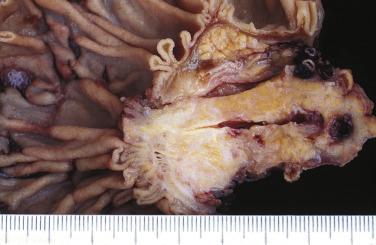
Most ductal adenocarcinomas are well to moderately differentiated, consisting mainly of tubular and ductlike structures composed of mucus-secreting cuboidal or columnar cells ( Fig. 11.2 ). The neoplastic glands are lined by a single cell layer, varying in height and often being ruptured. The nuclei of the cells usually are polarized and show little nuclear pleomorphism, but distinct nucleoli; mitotic activity is variable.
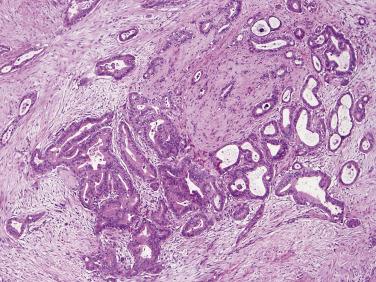
A few well-differentiated ductal adenocarcinomas are composed solely of tubules that infiltrate the parenchyma diffusely and may cause problems in the distinction from chronic pancreatitis. The majority of the well and moderately differentiated adenocarcinomas, however, show in addition to the tubular component other patterns which may be found as a focal feature or may predominate in the neoplasm. Special patterns that have been described are a foamy gland pattern (simple mucinous glands with bland, basal nuclei and a thick eosinophilic band at the luminal surface) ( Fig. 11.3 ), a large duct-type pattern (large, dilated simple glands that may even be visible grossly), a papillary pattern, a clear cell pattern ( Fig. 11.4 ), and a cribriform pattern.
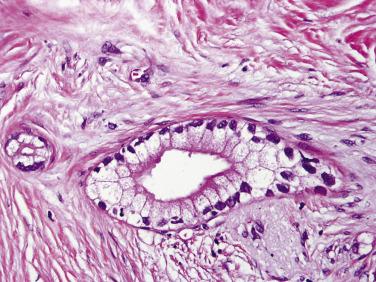
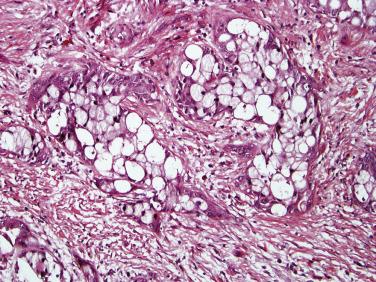
The neoplastic glands infiltrate through the pancreatic parenchyma, often along interlobular septa, so that nonneoplastic ducts, acini, and islets are variably interspersed with the carcinomatous elements. The infiltrating glands are typically associated with a striking desmoplastic stromal reaction to the extent that the stromal component of the tumor is often more abundant than the neoplastic epithelium. The cellular stroma consists of collagen fibers, myofibroblasts, lymphocytes, and macrophages.
In some moderately and all poorly differentiated carcinomas, the histologic pattern becomes progressively more irregular and complex, with poorly formed and cribriform glands intermingled with solid cell clusters and individual pleomorphic cells ( Fig. 11.5 ). There is increasing variation in cell and nuclear size and decreased mucous secretion. Mitotic figures become conspicuous. Carcinomas with micropapillary features and occasionally neutrophilic infiltration, first described in the breast, also occur in the pancreas as a manifestation of poor differentiation and aggressive behavior.
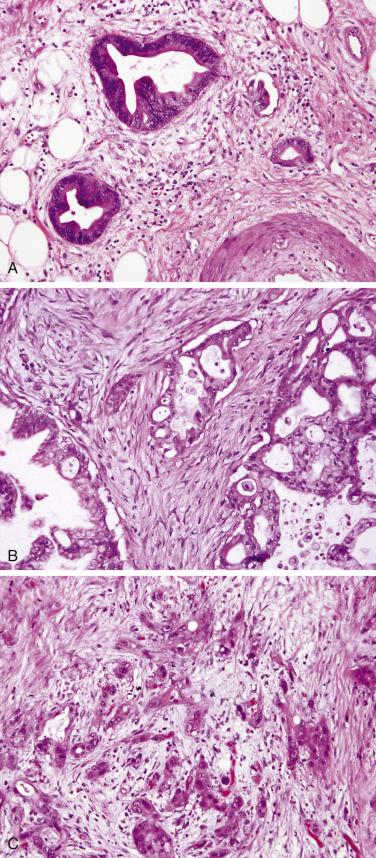
At the time of diagnosis ductal carcinomas are rarely confined to the pancreas. Spread into the peripancreatic fatty tissue as naked glands and combined with perineural invasion is almost universal. Moreover, there may be invasion of lymphatic vessels and veins. Because of ductal obstruction by the tumor, there is more or less severe obstructive chronic pancreatitis in the peritumoral pancreatic tissue or even in the entire remaining gland.
The midsize ducts adjacent to invasive carcinomas are commonly involved by PanIN (see upcoming discussion) ( Fig. 11.6 ). Of note, it is often difficult to distinguish precisely between a high-grade PanIN focus adjacent to but separate from the invasive carcinoma versus intraductal extension of the invasive carcinoma (duct colonization). In addition to PanIN lesions there may be squamous metaplasia ( Fig. 11.7 ), the occurrence of which in the pancreas seems to be unrelated to ductal adenocarcinoma or other tumors, but may be found after long-term stenting of the main pancreatic duct in chronic pancreatitis. Squamous metaplasia is not regarded as a precursor to carcinoma.
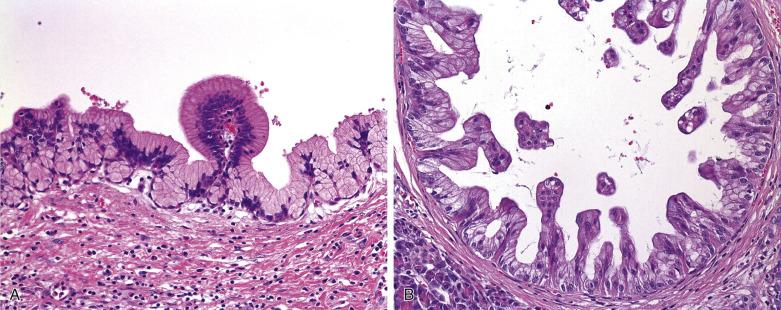
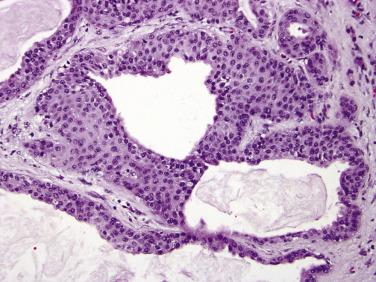
Pancreatic biopsy is performed to establish a definitive diagnosis prior to medical treatment, although in some clinical circumstances, surgical resection may be performed based only on clinical and radiographic findings because of the high false-negative rate for biopsies and the risk of complications such as acute pancreatitis. Because of advances in modern imaging techniques, fine-needle aspiration biopsy of the pancreas guided by ultrasonography, computer tomography, or endosonography has become a reliable method that allows the diagnosis of a ductal adenocarcinoma or any of the other less common pancreatic tumors with high sensitivity and specificity. Complications are rare, particularly with endosonographically guided biopsies. The diagnostic problems that are typically encountered in biopsy specimens relate to the differential diagnosis of pancreatic carcinoma versus chronic pancreatitis (see paragraph on differential diagnosis ), the distinction among various types of pancreatic tumors, and issues related to sampling ( Table 11.2 ). Intraoperative frozen section assessment of pancreatic lesions also focuses on distinguishing between ductal carcinoma and chronic pancreatitis. The criteria to diagnose carcinoma on frozen section are similar to those used for biopsies, although frozen section artifacts may complicate interpretation. Frozen section diagnosis may be problematic in a given case, but accuracy rates of up to 98% have been reported.
| Imaging | DIFFERENTIAL DIAGNOSIS | |
|---|---|---|
| Benign | Malignant | |
| Solid mass of uncertain biology | Common: Alcoholic chronic pancreatitis Rare: Autoimmune pancreatitis Neuroendocrine tumor |
Ductal adenocarcinoma Neuroendocrine neoplasm Acinar cell carcinoma Malignant mesenchymal tumor Lymphoma Metastasis |
| Cystic mass | Pseudocyst Serous cystadenoma Various nonneoplastic cysts |
Mucinous cystic neoplasm Intraductal papillary mucinous neoplasm Intraductal oncocytic papillary neoplasm Intraductal tubulopapillary neoplasm |
There is no marker that clearly distinguishes ductal adenocarcinoma from other extrapancreatic adenocarcinomas (notably bile duct and gastric carcinomas), but there is a marker panel that consistently, if nonspecifically, labels ductal adenocarcinoma. It includes positive immunolabeling for the cytokeratins 7, 8, 18, and 19; epithelial membrane antigen (EMA); carcinoembryonic antigen (CEA); and CA19-9, B72.3, CA125, or DUPAN-2. More than 50% of ductal adenocarcinomas also express CK20. Moreover, they are usually positive for MUC1, MUC3, MUC4, and MUC5AC (but not MUC2) ( Fig. 11.8 ). The gene product of the SMAD4 (DPC4) is lost in 55% of the carcinomas ( Fig. 11.9 ), and the p53 protein is abnormally expressed in about 60% of the cases. On the other hand, ductal adenocarcinomas generally fail to stain for vimentin, pancreatic enzymes (such as trypsin), and neuroendocrine markers ( Table 11.3 ). Growth factors and adhesion molecules overexpressed by ductal adenocarcinomas include epidermal growth factor and its receptor, c-erbB-2, transforming growth factors alpha and beta, platelet-derived growth factors A and B, vascular endothelial growth factor and its receptors, metallothionein, CD44v6, and membranous E-cadherin and ß-catenin. Albumin message expression, demonstrable using fluorescence in situ hybridization (FISH) in hepatocellular carcinomas and peripheral type cholangiocarcinomas, is not found in pancreatic carcinomas.
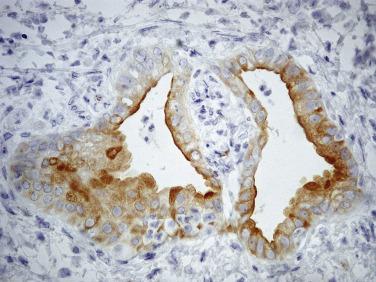
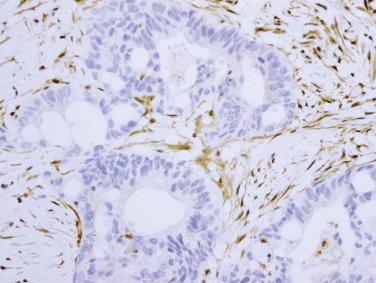
| CK 7,19 |
CK 8, 18 |
MUC1 | MUC2 | TRYP | SYN | CG | CEA | AFP | |
|---|---|---|---|---|---|---|---|---|---|
| Ductal adenocarcinoma | + | + | + | - | - | - | - | + | - |
| Intraductal papillary mucinous neoplasm | + | + | + a | + b | - | - | - | + | ND |
| Mucinous cystic neoplasm | + | + | + | - | - | - | - | + | - |
| Serous cystadenoma | + | + | - | - | - | - | - | - | - |
| Acinar cell carcinoma | +/- | + | - | - | + | +/- | +/- | - | + |
| Pancreatoblastoma | + | + | - | - | + | +/- | +/- | - | + |
| Solid pseudopapillary neoplasm | - | - | - | - | - | - | - | - | - |
| Neuroendocrine neoplasm | +/- | + | - | - | - | + | + | - | - |
Pancreatic ductal adenocarcinoma is among the best characterized neoplasms at the genetic level thanks to recent large whole-exome and whole-genome sequencing studies. Briefly, there are four genetic mountains (genes that are targeted in >50% of the cancers). These include an oncogene, KRAS , and three tumor suppressor genes ( p16 / CDKN2A, TP53 , and SMAD4 ). KRAS is activated in more than 90% of ductal adenocarcinomas by point mutations. KRAS mutations usually target a hot spot at codon 12, but they may also affect codons 13 and 61. Similarly, CDKN2A is inactivated in 95% by intragenic mutations coupled with loss of the second allele (loss of heterozygosity, LOH), by homozygous deletion, or by epigenetic silencing. TP53 and SMAD4 are inactivated in approximately 75% and 55%, respectively, by homozygous deletion or by an intragenic mutation coupled with LOH. There are also a number of genes that are targeted in a minority of pancreatic cancers such as ARID1A , ATM , AKT2 , MAP2K4 , MLL2, MLL3 , TGFβR2 , ROBO2, and KDM6A.
In addition to these somatic mutations, a number of germline genetic alterations have been identified that predispose the person carrying the germline genetic alteration to the development of pancreatic cancer (see also epidemiology ). These include BRCA2 , BRCA1 , PALB2 , p16 / CDKN2A , STK11 , ATM , PRSS1 , and the DNA repair genes (such as MLH1 and MSH2 ). These germline alterations are critical to understand because the risk is significant and at-risk patients can be enrolled in screening and early detection protocols for pancreatic and extrapancreatic tumors.
Similarly, patients with specific genetic alterations can be prioritized for specific therapies. Despite the diversity of genes targeted, the genetic alterations in ductal adenocarcinoma appear to selectively involve core signaling pathways such as Wnt/Notch signaling, TGF-β signaling, and DNA damage control. Targeting one or more of these pathways may be more effective than targeting a specific genetic alteration. For example, some tumors characterized by microsatellite instability due to a DNA repair gene defect are exquisitely responsive to immunotherapies, and some tumors with BRCA or PALB2 gene mutation are sensitive to poly ADP ribose polymerase (PARP) inhibitors.
The main diagnostic problem is distinguishing well-differentiated ductal adenocarcinoma from chronic pancreatitis. Macroscopically, both diseases can appear similar. If, however, calculi are present in the pancreatic ducts, the diagnosis of advanced chronic pancreatitis is most likely. Microscopically, the criteria that are applied are relevant for both biopsy specimens (including frozen sections) and large tissue specimens ( Table 11.4 ). At low-power magnification, ductal adenocarcinomas show haphazardly arranged infiltrating tubular and ductlike structures that lack any lobular organization. Some of the neoplastic ducts may be ruptured, show papillary epithelium, and are encased by desmoplastic stroma ( Fig. 11.10 ). In chronic pancreatitis, the remaining small ducts, single acini, and islets usually show a preserved lobular arrangement. Some ducts may be dilated and contain calculi. Another finding favoring a diagnosis of carcinoma is abnormal location of glands adjacent to muscular vessels, around nerves, or touching adipocytes (without any intervening stroma). At high-power magnification, ductal adenocarcinomas show variable epithelial atypia and often mitotic figures. In addition, the nuclei are often not well polarized and exhibit prominent nucleoli. A fourfold variation in nuclear size within an individual gland is strongly suggestive of carcinoma. In chronic pancreatitis, the ductal epithelium may be atrophic or occasionally hyperplastic, but atypia and mitoses are usually absent. Immunohistologically, there is no marker with both high sensitivity and specificity, but strong cytoplasmic expression of MUC1, B72.3, CA125, and CEA is highly indicative of carcinoma, as is complete loss of expression of SMAD4/DPC4 . p53 and Ki-67 is also significantly more abundant in carcinoma than in normal epithelium although overlaps are common, and these stains ought to be used cautiously. For the differential diagnosis of ductal adenocarcinoma versus other pancreatic tumors such as intraductal papillary mucinous neoplasms, acinar cell carcinomas, or neuroendocrine tumors, refer to Table 11.3 . Distinguishing between ampullary adenocarcinoma and pancreatic carcinoma is discussed in Chapter 9 .
| Ductal Adenocarcinoma | Chronic Pancreatitis | |
|---|---|---|
| DUCTAL FEATURES | ||
| Distribution | Irregular, haphazard | Organized, lobular |
| Location | Perineural, intravascular, extrapancreatic (naked ducts in fat tissue) | Intrapancreatic |
| Contours | Rupture | Intact ducts |
| Contents | Neutrophils, necrotic debris | Calculi, secretory plugs |
| CYTOLOGIC FEATURES | ||
| Nucleus | Pleomorphic Mitosis Prominent nucleoli |
Uniform, round-oval No mitosis No or small nucleoli |
| Nuclear polarity | Commonly lost | Retained |
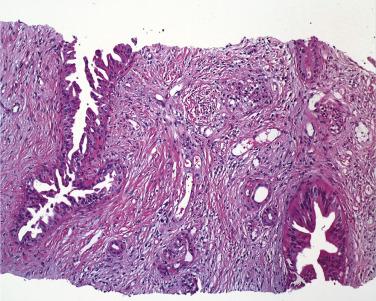
Recommendations are available for the standardized processing and accurate staging of resected pancreatic carcinomas. Ductal adenocarcinomas spread early to the retroperitoneal tissues and the various local peripancreatic lymph node groups, the precise topography of which depends on the location of the primary tumor. Involvement of the regional lymph nodes (i.e., in the hepatoduodenal ligament up to the celiac trunk) is found in about 50% of resected cases; involvement of the juxtaregional, mainly paraaortic lymph nodes occurs in about 10%. Hepatic bloodborne metastases are frequent. Metastases to lungs, pleura, and bone are seen only in advanced tumor stages, particularly with tumors of the body or tail; cerebral metastases are uncommon.
The current pathologic staging of ductal adenocarcinoma ( AJCC Cancer Staging Manual, 8th edition) is based on the TNM classification. In this edition, extrapancreatic extension is no longer part of the T-stage definition; T stage is based on the tumor size. Node-positive disease has also been subdivided into N1 and N2, based on number of positive lymph nodes ( Table 11.5 ).
| DEFINITION OF PRIMARY TUMOR (T) | |||
| TX | Primary tumor cannot be assessed | ||
| T0 | No evidence of primary tumor | ||
| Tis | Carcinoma in situ This includes high-grade pancreatic intraepithelial neoplasia (PanIN3), intraductal papillary mucinous neoplasm with high-grade dysplasia, intraductal neoplasm with high-grade dysplasia, and mucinous cystic neoplasm with high-grade dysplasia. |
||
| T1 | Tumor ≤2 cm in greatest dimension | ||
| T1a | Tumor ≤0.5 cm in greatest dimension | ||
| T1b | Tumor >0.5 cm and <1 cm in greatest dimension | ||
| T1c | Tumor 1–2 cm in greatest dimension | ||
| T2 | Tumor >2 cm and ≤4 cm in greatest dimension | ||
| T3 | Tumor >4 cm in greatest dimension | ||
| T4 | Tumor involves celiac axis, superior mesenteric artery, and/or common hepatic artery, regardless of size | ||
| DEFINITION OF REGIONAL LYMPH NODES (N) | |||
| NX | Regional lymph nodes cannot be assessed | ||
| N0 | No regional lymph node metastasis | ||
| N1 | Metastasis in one to three regional lymph nodes | ||
| N2 | Metastasis in four or more regional lymph nodes | ||
| DEFINITION OF DISTANT METASTASIS (M) | |||
| MX | Distant metastasis cannot be assessed | ||
| M0 | No distant metastasis | ||
| MI | Distant metastasis | ||
| AJCC PROGNOSTIC STAGE GROUPS | |||
| When T is… | And N is… | And M is… | Then the stage group is… |
| Tis | N0 | M0 | 0 |
| T1 | N0 | M0 | IA |
| T1 | N1 | M0 | IIB |
| T1 | N2 | M0 | III |
| T2 | N0 | M0 | IB |
| T2 | N1 | M0 | IIB |
| T2 | N2 | M0 | III |
| T3 | N0 | M0 | IIA |
| T3 | N1 | M0 | IIB |
| T3 | N2 | M0 | III |
| T4 | Any N | M0 | III |
| Any T | Any N | M1 | IV |
The currently available grading schemes for ductal adenocarcinomas both follow a three-tiered system. Outcome data have shown that the biologically most relevant distinction is that of G1/G2 versus G3.
Neoadjuvant chemoradiation has been used increasingly as a therapeutic approach in addition to surgical resection. Several scoring systems are available for evaluation of the extent of residual carcinoma in posttherapy resection specimens. Correlation of the extent of residual carcinoma with survival reveals that patients with less than 5% viable residual tumor have a much better disease-free and overall survival than those with more than 5% viable residual tumor.
Become a Clinical Tree membership for Full access and enjoy Unlimited articles
If you are a member. Log in here